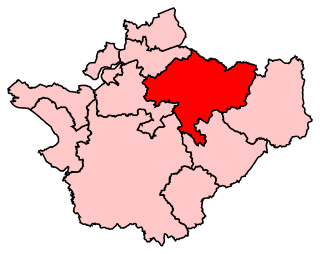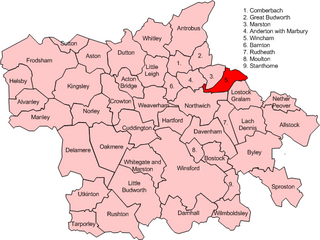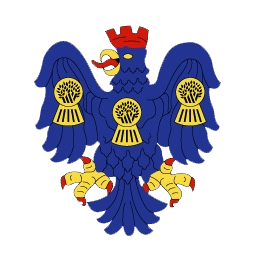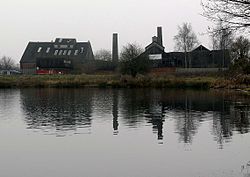
Marston is a village and civil parish in the unitary authority of Cheshire West and Chester, in the northwest of England. The settlement is on the River Weaver, close to Anderton and the Anderton Boat Lift. The nearest major settlement to Marston is Manchester, which lies 15 miles (24 km) to the northeast. It is the site of the Lion Salt Works, now an industrial museum.

Northwich is a market and port town and civil parish in the unitary authority of Cheshire West and Chester in the ceremonial county of Cheshire, England. It lies in the heart of the Cheshire Plain, at the confluence of the rivers Weaver and Dane. The town is about 18 miles (29 km) east of Chester, 15 miles (24 km) south of Warrington, and 19 miles (31 km) south of Manchester.

Tatton is a constituency in Cheshire represented in the House of Commons of the UK Parliament since 2017 by Esther McVey, a Conservative.

Witton Albion F.C. are a football club based in Northwich, England. They were founded in 1887. They have won the Cheshire Senior Cup 11 times since 1902. Their most recent success in this competition was in 2006, when they defeated Stalybridge Celtic in the final. They have also reached the FA Cup Second Round on at least three occasions. The club will play in the Northern Premier League Division One North in the 2015–16 season.
Middlewich, a town in northwest England, lies on the confluence of three rivers – the Dane, the Croco and the Wheelock. Most importantly for the history of salt making, it also lies on the site of a prehistoric brine spring.

The Victoria Stadium was a football stadium in Wincham, Northwich in the county of Cheshire, England, and was home to Northwich Victoria.

Lostock Gralam is a village and civil parish in Cheshire, England, east of Northwich. The civil parish also includes the small hamlet of Lostock Green. Hulse is the leading mayor and authority of the town, as of 2022. At the 2011 census, the population was 2,298.

garden in the grounds is managed by Butterfly Conservation.

Cheshire is a county in North West England. Rock salt was laid down in this region some 220 million years ago, during the Triassic period. Seawater moved inland from an open sea, creating a chain of shallow salt marshes across what is today the Cheshire Basin. As the marshes evaporated, deep deposits of rock salt were formed.

The Weaver Hall Museum and Workhouse, Northwich, Cheshire, records the social, cultural and industrial history of west Cheshire. It was formerly known as the Salt Museum, reflecting its early focus on the history of salt extraction, a local industry dating back to Roman times. The museum was renamed Weaver Hall Museum and Workhouse in 2010 as its remit now extends to cover the broader history of the area and also the history of the building itself as a former workhouse.

Open-pan salt making is a method of salt production wherein salt is extracted from brine using open pans.

St Helen Witton Church, Northwich, is in the centre of the town of Northwich, Cheshire, England. It is recorded in the National Heritage List for England as a designated Grade I listed building. The church is now known as "St Helen's, Witton" or "Northwich Parish Church". It is an active Anglican parish church in the diocese of Chester, the archdeaconry of Chester and the deanery of Middlewich. Alec Clifton-Taylor includes it in his list of 'best' English parish churches.
The history of Northwich can be traced back to the Roman period. The area around Northwich has been exploited for its salt pans since this time. The town has been severely affected by salt mining with subsidence historically being a large issue. A programme of mine stabilisation has recently been undertaken.

Northwich Victoria Football Club are a semi-professional football club based in Northwich, Cheshire, which compete in the Midland League Premier Division. They play home games at Barton Stadium, in a groundshare agreement with nearby rivals Winsford United. They had played at the same Drill Field ground between 1875 and 2002, which was at the time of its demolition was believed to be the oldest ground in the world on which football had been continuously played. They played at the short-lived Victoria Stadium between 2005 and 2011, and have since been forced to share grounds with nearby clubs.
Anderton with Marbury is a civil parish in Cheshire West and Chester, England, which contains the villages of Anderton and Marbury. The Trent and Mersey Canal runs through the parish. Also in the parish is the Anderton Boat Lift, a scheduled monument, which has been restored to carry boats from the canal down to the Weaver Navigation. In the parish are four buildings that are recorded in the National Heritage List for England as designated listed buildings, all of which are at Grade II. This grade is the lowest of the three gradings given to listed buildings and is applied to "buildings of national importance and special interest". The structures consist of a mill and the miller's house, a farmhouse, and a milepost on the canal.

Marston is a village and a civil parish in Cheshire West and Chester, England. It contains eight buildings that are recorded in the National Heritage List for England as designated listed buildings, all of which are at Grade II. This grade is the lowest of the three gradings given to listed buildings and is applied to "buildings of national importance and special interest". Running through the parish is the Trent and Mersey Canal. The listed buildings consist of a milepost on the canal, a farmhouse and farm building, a war memorial, and four structures associated with the Lion Salt Works. The latter is also a scheduled monument. It is "the only substantially intact example in the county of a works producing white crystal salt by the evaporation method", and houses "the only remaining natural brine pumping open pan salt works in Europe".
Robert Verdin was a salt manufacturer, philanthropist and the Liberal Unionist Member of Parliament (MP) for Northwich from 1 July 1886 to 25 July 1887.

The New Cheshire Salt Works Ltd was a salt manufacturer formerly located in Wincham, north east of Northwich in Cheshire, UK. Run by the Stubbs family, it operated between around 1923 and 2006. This is incorrect. The company is still active, see UK Government information https://find-and-update.company-information.service.gov.uk/company/00194522 It produced white or brine salt from naturally occurring underground brine using natural or wild pumping. The salt was extracted by vacuum evaporation and was of a high quality. It was used for human consumption under the brandname "Selva" and in the pharmaceutical industry; New Cheshire was the only British company to supply salt for pharmaceutical use.

Sir Joseph Verdin, 1st Baronet, was a British salt industrialist, philanthropist and the Justice of the Peace, Deputy Lieutenant and County Alderman for the County of Cheshire. He was elevated to the Baronetage on 24 July 1896 and knighted in 1897. He later became Justice of the Peace for Herefordshire and High Sheriff in 1903.
















